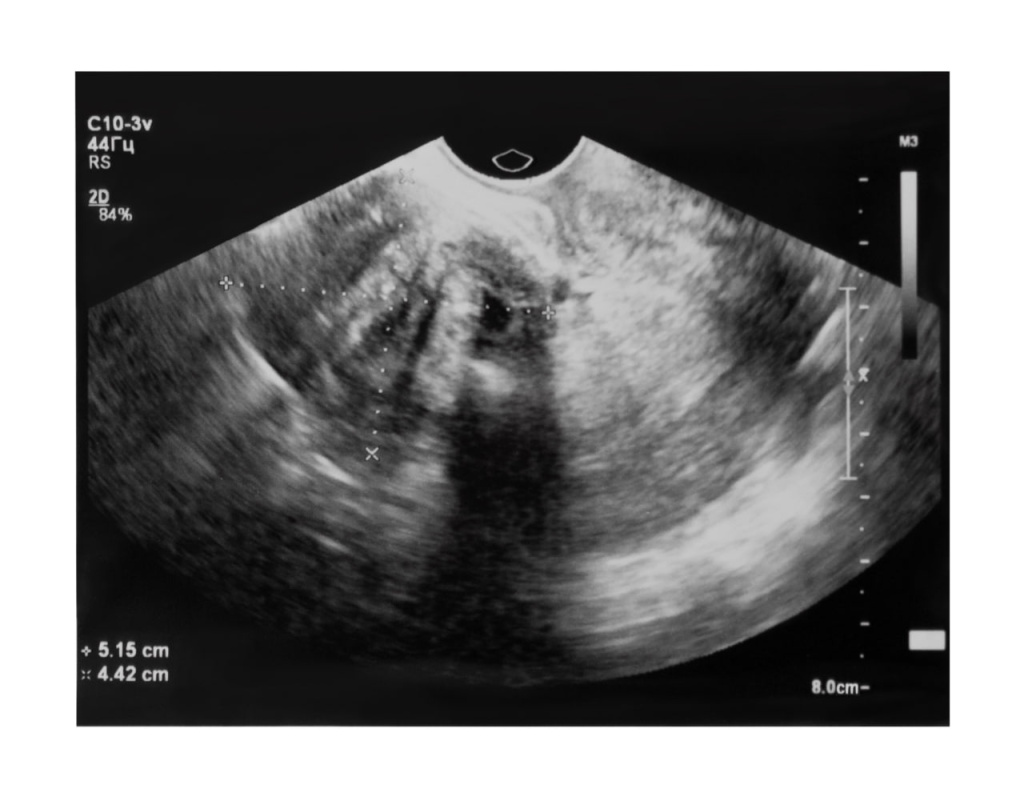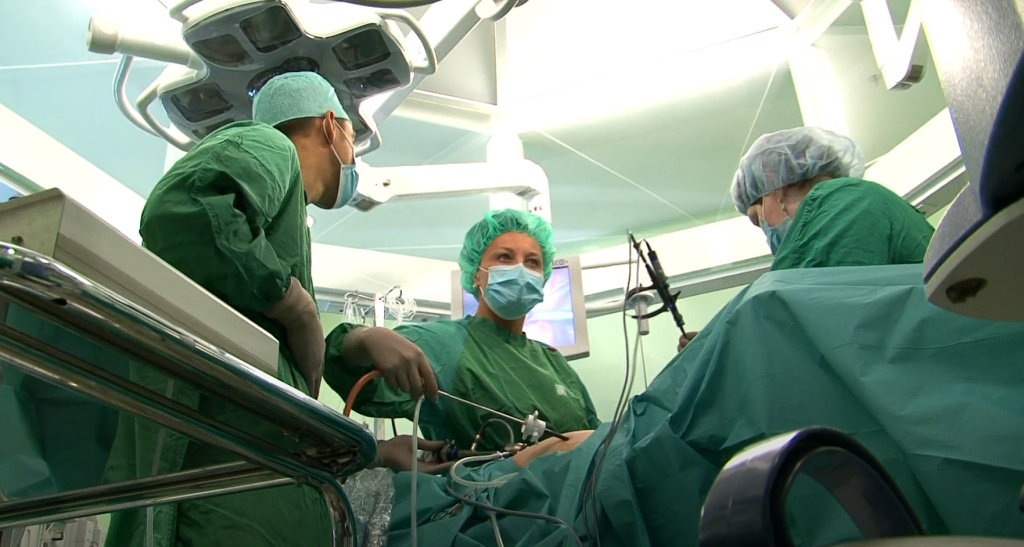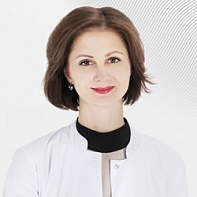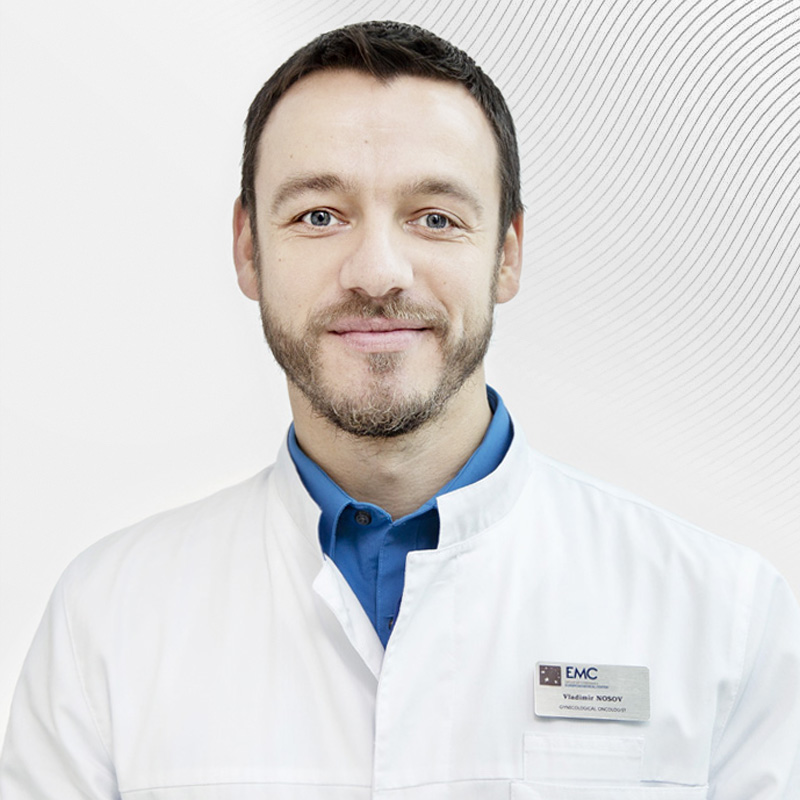Laparoscopy of uterine fibroids
Laparoscopic surgery in gynecology is an opportunity to perform accurate and safe intervention with minimal risk of complications for a woman's complex and fragile reproductive system. In the EMC clinic, laparoscopic surgeries are actively used to treat uterine fibroids. The advantages of our clinic are the highest qualification of surgeons, advanced medical equipment, the latest treatment methods, and the ability to avoid removal of the uterus even in the most difficult cases.
Uterine fibroids
Uterine fibroids are benign tumorous formations in the form of one or more nodules. Fibroids appear in women of reproductive age and quite often develop unnoticed by the patient without any symptoms, therefore they are detected accidentally during examinations for another reason.However, depending on the size and location of the myomatous nodes, the following symptoms may occur:
-
prolonged and heavy menstruation;
-
with large fibroids, there is a feeling of pressure in the lower abdomen;
-
problems with the urinary system (frequent urination) and rectum (bowel movements);
-
pain syndrome (pain in the lower abdomen, may radiate to the lower back, may occur or worsen after sexual contact).
Depending on the location, fibroids can also prevent conception or gestation. However, this pathology is not dangerous in itself and never becomes malignant, that is, it does not turn into a malignant tumor.
Small fibroids that grow slowly and do not cause inconvenience to the patient usually do not need treatment. Important conditions— the patient is not planning pregnancy and does not suffer from iron deficiency anemia. Under such conditions, doctors prefer wait-and-see tactics and regular routine checkups to monitor growth and educational status. But sometimes, in order to improve a woman's quality of life, treatment is indicated — surgery to remove uterine fibroids.

What is fibroids laparoscopy
Laparoscopic removal of uterine fibroids is a minimally invasive surgical operation in which the neoplasm is removed, but;the uterus is preserved. With this method of treatment, the patient's reproductive function does not suffer, and after the recovery period, the woman has a fairly high chance of becoming pregnant and successfully carrying a child.
Laparoscopic surgery occurs in a closed manner, through several small punctures up to 1 cm in size, which completely cease to be noticeable 6-8 months after surgery. Other advantages of the method:
-
minimal injury;
-
there is practically no blood loss;
-
extremely low risk of infection;
-
rapid rehabilitation;
-
excellent cosmetic effect;
-
In many cases, it is more efficient than open access.
Indications for removal of uterine fibroids
Surgery is prescribed if:
-
The patient was diagnosed with anemia due to heavy blood loss during menstruation;
-
There are symptoms associated with the large size of the neoplasm: abdominal enlargement, impaired function of neighboring organs.;
-
fibroids have a size of more than 6 cm, or they grow rapidly (by more than 2 cm per year);
-
the knot has a leg, which creates a risk of twisting;
-
signs of neoplasm necrosis have been diagnosed;
-
the patient is planning a pregnancy, or fibroids are associated with fertility disorders.
Contraindications
A contraindication to laparoscopic surgery is the gigantic size of fibroids (more than 20 cm). In this case, microsurgical treatment of fibroids is not possible. Laparoscopy is also not performed in the following cases:
-
infectious diseases in the acute stage;
-
severe decompensated somatic pathologies;
-
pregnancy after the 2nd trimester;
Preparation
Laparoscopic surgery for uterine fibroids is performed after a thorough examination of the patient. When preparing for surgery, it is necessary to undergo a number of laboratory and instrumental examinations:
-
complete gynecological examination, including microbiological smear analysis and cervical scraping for oncocytology;
-
Ultrasound of the pelvic organs;
-
hospital profile tests (general and biochemical blood analysis, urine analysis, coagulogram, tests for HIV, syphilis, hepatitis);
-
The ECG.
The operation is performed under general anesthesia, so the patient needs to consult an anesthesiologist before surgery. To reduce the risks to the patient's health, when preparing for surgery, the patient should follow all the doctor's recommendations, including abstaining from food and drink during the specified time, and also, if necessary, discontinue certain medications.
How the operation is performed
The doctor performs several punctures in the abdominal wall. A hollow instrument is inserted through one of them, through which the abdominal cavity is filled with gas. This allows you to lift the abdominal wall and provides access to the uterine nodes. A laparoscope is inserted into the second incision — a small probe with a miniature video camera mounted on it, which provides visual monitoring of medical manipulations. The remaining punctures are necessary for microsurgical instruments, which the surgeon uses to incise the uterine wall, peel out fibroids, stop bleeding, and suture. Excised tissues are removed through incisions after fragmentation with a special shaver.

Rehabilitation
The duration of rehabilitation depends on the volume of the operation and the number of nodes removed. Usually, the patient stays in the hospital for 1-2 days, but in rare cases, the period of hospitalization has to be extended. In the postoperative period, minor subcutaneous secretions may occur. Full recovery takes up to 2 weeks, however, if work is not physically demanding, a woman can return to work duties on the fifth day after surgery. During the recovery period, the patient must observe physical and sexual rest, but moderate physical activity is necessary to prevent adhesions.
Frequently asked questions
When is the best time to have fibroids removed?
As planned, fibroids laparoscopy is prescribed mainly in the first phase of the menstrual cycle. During this period, the doctor can be sure of the nature of the discharge and the absence of pregnancy. For emergency indications (leg twisting, necrosis, etc.), fibroids can be removed on any day of the cycle.
How long does the uterus heal after fibroids are removed?
It is recommended that the patient resume sexual activity no earlier than 2-3 weeks after surgery to remove uterine fibroids. The first monthly periods will come at the same time as if there had been no surgery, fertility is restored by the second month, however, the scar on the uterus creates certain risks for carrying a child. Therefore, if a woman is planning pregnancy, it will be possible to cancel contraception no earlier than 6-9-12 months after surgery, after examination and coordination with the attending physician of each individual case.
What can not be done after surgery?
After the operation and until full recovery, the woman is put on bed rest first, and then a protective regime. For the first few weeks, it is recommended to avoid baths and saunas, taking baths, swimming in open water and swimming in the pool. During the first month after surgery, restrictions are also imposed on sexual activity. To prevent the seam from diverging, you should refrain from physical exertion, weight lifting, and abs exercises during the 1st month.
What happens to the body after fibroids are removed?
After removal of fibroids, women suffering from pathology-related symptoms note their relief. The intensity and duration of menstruation decrease, the feeling of pressure on the rectum and bladder disappears, pelvic pain disappears. If uterine fibroids were a factor in infertility, laparoscopic myomectomy in many cases helps restore reproductive function. However, fibroids laparoscopy cannot prevent the formation of new nodules, so the patient needs to undergo preventive examinations to detect new growths in a timely manner.
How long does the operation take?
Laparoscopic myomectomy can last from 30 to 120 minutes depending on the complexity.
How long does the stomach hurt after excision of a benign tumor?
Lower abdominal pain after surgery can be felt for 2-3 weeks. These are mild pulling pains, reminiscent of menstrual pain, which are easily relieved with over-the-counter painkillers. If the pain worsens or interferes with daily activities, you should notify your doctor.
At the EMC Clinic, gynecological operations are performed by international-class surgeons using the latest laparoscopic and robotic equipment. You can make an appointment for a gynecologist's consultation and ask any questions about our services by calling +7 495 933-66-55.
Doctors




.jpg)



.jpg)

.jpg)

- An expert oncogynecologist is a surgeon with more than 26 years of experience, including experience working in leading hospitals in the USA
- A leading Russian specialist in the field of robotic surgery in oncogynecology
- Graduated from the Moscow Medical Academy named after I.M. Sechenov
- Graduated from the Moscow Medical Academy named...




